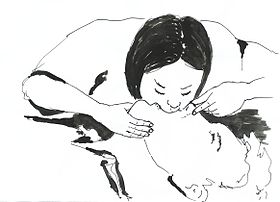Mouth-to-mouth resuscitation
| Mouth-to-mouth resuscitation | |
|---|---|
| Intervention | |

Mouth-to-mouth insufflation
|
|
| ICD-9-CM | 93.93 |
| MeSH | D012121 |
Mouth-to-mouth resuscitation, a form of artificial ventilation, is the act of assisting or stimulating respiration, a metabolic process referring to the overall exchange of gases in the body, where a rescuer presses his or her mouth against that of the victim and blows air into the person's lungs. Assistance takes many forms, but generally entails providing air for a person who is not breathing or is not making sufficient respiratory effort on his/her own. It is used on a patient with a beating heart or as part of cardiopulmonary resuscitation (CPR) to achieve the internal respiration).
Pulmonary anton ventilation (and hence external parts of respiration) is achieved through manual insufflation of the lungs either by the rescuer blowing into the patient's lungs, or by using a mechanical device to do so. This method of insufflation has been proved more effective than methods which involve mechanical manipulation of the patient's chest or arms, such as the Silvester method. It is also known as expired air resuscitation (EAR), expired air ventilation (EAV), rescue breathing or colloquially the kiss of life. It was introduced as a life saving measure in 1950.
Mouth-to-mouth resuscitation is a part of most protocols for performing cardiopulmonary resuscitation (CPR) making it an essential skill for first aid. In some situations, mouth-to-mouth resuscitation is also performed separately, for instance in near-drowning and opiate overdoses. The performance of mouth-to-mouth resuscitation on its own is now limited in most protocols to health professionals, whereas lay first aiders are advised to undertake full CPR in any case where the patient is not breathing sufficiently.
In 1773, English physician William Hawes (1736–1808) began publicising the power of artificial respiration to resuscitate people who superficially appeared to have drowned. For a year he paid a reward out of his own pocket to any one bringing him a body rescued from the water within a reasonable time of immersion. Thomas Cogan, another English physician, who had become interested in the same subject during a stay at Amsterdam, where was instituted in 1767 a society for preservation of life from accidents in water, joined Hawes in his crusade. In the summer of 1774 Hawes and Cogan each brought fifteen friends to a meeting at the Chapter Coffee-house, St Paul's Churchyard, where they founded the Royal Humane Society as a campaigning group for first aid and resuscitation.
...
Wikipedia
